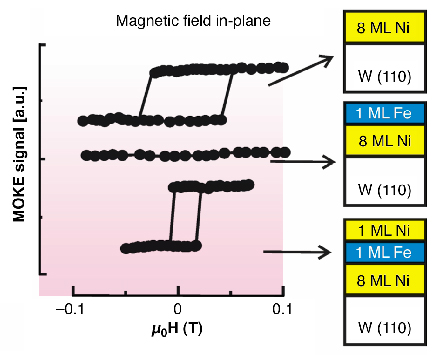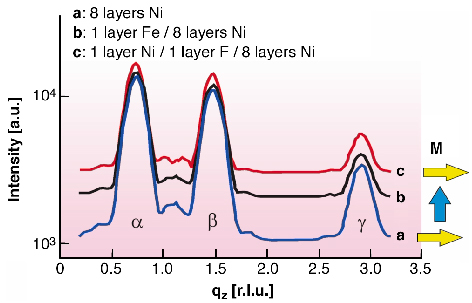- Home
- Users & Science
- Scientific Documentation
- ESRF Highlights
- ESRF Highlights 2004
- Surface and Interface Science
- Spin Reorientation and Structural Relaxation of Atomic Layers: Pushing the Limits of Accuracy
Spin Reorientation and Structural Relaxation of Atomic Layers: Pushing the Limits of Accuracy
The direction of the magnetisation in magnetic materials is pinned along certain crystal directions. In addition to its fundamental interest, this magnetic anisotropy is important for technological applications. For example, in future high-density magnetic recording devices, magnetic alloys will be used where the easy magnetisation direction is perpendicular to the disk plane.
In ultra-thin films, only several atomic layers thick, it is often observed that the easy magnetisation direction changes with adsorption of a single atomic layer of ad-atoms. One example is Ni/W(110). Magneto optic Kerr effect (MOKE) measurements indicate that, after deposition of several layers of Ni, the magnetisation lies in the plane as shown in Figure 88 by the magnetisation curve with almost full remanence when measured in the longitudinal geometry (upper panel). Deposition of a single layer of Fe switches the easy axis to the normal direction (no hysteresis observed, centre), while another layer of Ni reverts it back to in-plane (lower panel).
 |
Fig. 88: n-plane magnetisation curves for Fe/Ni/W(110). Sample structures are shown schematically on the right. |
In general, adsorbate-induced spin reorientations are explained by an anisotropy change due to surface modification. However, quantitative estimations indicate that the change of the magnetisation direction can also be induced by changes of the interlayer spacing in the percent range[1]. Here, a lattice spacing change of only 0.015 Å would be sufficient to induce a spin reorientation. Since this is in the limit of accuracy of surface structure analysis techniques, the magneto-elastic contribution is generally not discussed and analysed in detail.
In order to study the adsorbate-induced structural change, and its impact on the magnetic anisotropy, surface X-ray diffraction experiments were carried out at the beamline ID03 and combined with MOKE. Our experimental approach is based on the determination of relative peak shifts before and after layer deposition as shown in Figure 89.
 |
|
Fig. 89: X-ray scans along the surface normal after subsequent deposition of 8 layers of Ni (a),one layer of Fe (b) and another layer of Ni (c). Arrows indicate the easy magnetisation direction. Peak shifts are smaller than 5x10-4 reciprocal lattice units corresponding to changes of the interlayer spacing below about 0.002 Å. |
Surface X-ray diffraction measurements along the sample normal were carried out probing the vertical lattice spacing of the Ni film. Scans were measured after subsequent deposition of eight Ni- layers (a), one Fe-layer (b), and another Ni-layer (c). Three Bragg-peaks are observed, where the first (![]() ) and the third (
) and the third (![]() ) are related to the (101)- and (104) reflection of the fcc-like Ni-structure, while the second (ß) represents the reflection from the crystallographic twin.
) are related to the (101)- and (104) reflection of the fcc-like Ni-structure, while the second (ß) represents the reflection from the crystallographic twin.
Detailed analysis of the peak positions and the profiles indicate that adsorption of one layer of Fe does not result in changes of the average interlayer distances larger than 0.002 Å. This is roughly one order of magnitude smaller than calculated (0.015 Å) necessary for a magneto-elastic driven switching of the easy axis. Therefore, the change of the easy axis must be attributed to the modification of the electronic structure of the surface layer due to adsorption, and this changes the magnetic surface anisotropy.
Our experimental procedure as well as the result have far reaching implications for the preparation of suitable magnetic systems, since the unprecedented accuracy of the near-surface structure determination allows a clear unravelling of the different factors contributing to the magnetic anisotropy.
References
[1] D. Sander, Rep. Prog. Phys 62, 809 (1999).
Principal Publication and Authors
H.L. Meyerheim (a), D. Sander (a), R. Popescu (a), J. Kirschner (a), O. Robach (b), S.Ferrer (b, c), Phys. Rev. Lett. 93, 156106 (2004).
(a) MPI für Mikrostrukturphysik, Halle (Germany)
(b) ESRF
(c) also at: ALBA, Barcelona (Spain)



